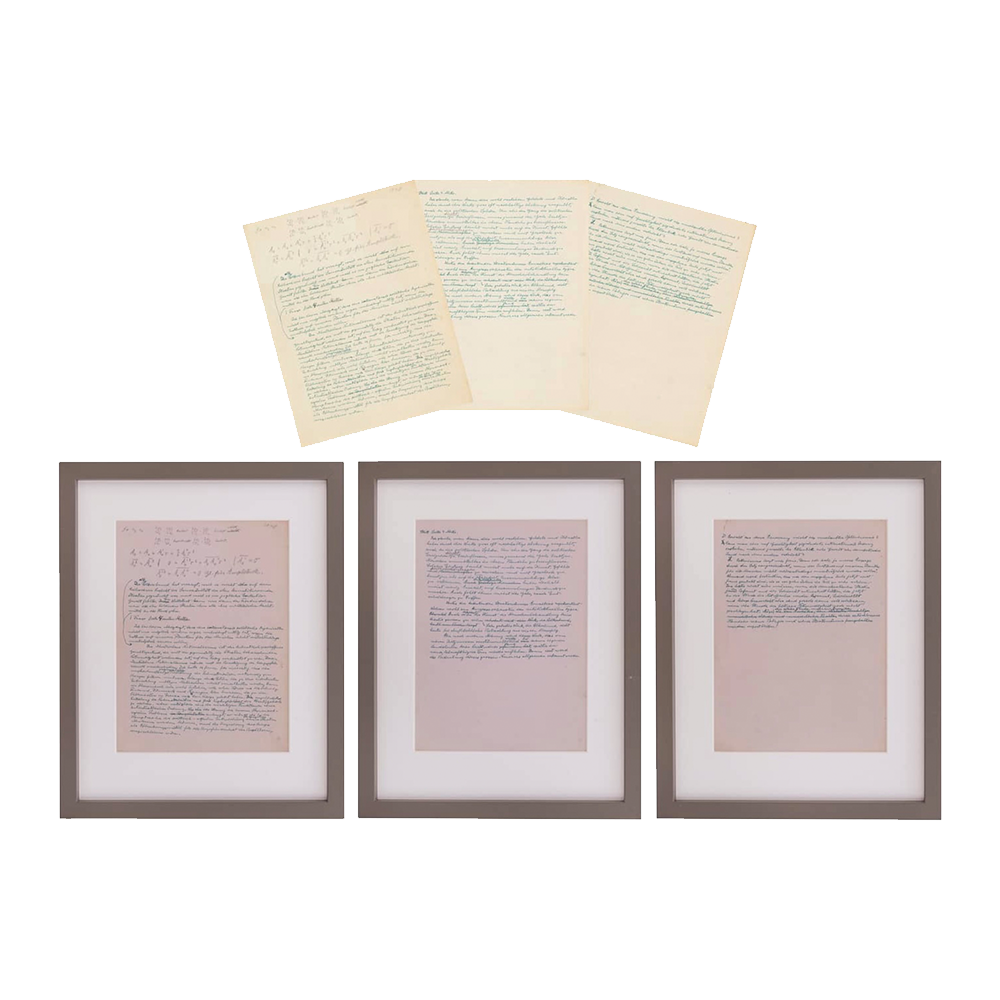ALBERT EINSTEIN,
THE THEORY OF WORLD PEACE
A three-page manuscript written in full by Albert Einstein in 1940. The first part of the first page contains handwritten mathematical equations regarding electromagnetic fields. The page later continues with Einstein's explaining how to achieve world peace – hence The Theory of World Peace.
The manuscript is written during the Second World War, and a lot of Einstein's points do recollect with what later became the United Nations; one example is the following. "A World State (great power) is capable of securing peace only if all its constituting member states turn over all their power to that one state." Einstein also advises how a change is capable of becoming a reality by writing, "However, in order to directly influence political events, one must have the talent to be able to directly influence the actions of human beings."
Page 1 of the remarkable German-language manuscript contains a series of potentially important mathematical equations. Then Einstein launches into the text by discussing the failure of the League of Nations "because it was not founded on a partial renunciation of sovereignty by its member states and because it lacked any kind of executive power." Further, Einstein makes this bold declaration: "A world state can only ensure peace if its constituent states hand over all their military resources to it." He then critiques "exaggerated nationalism" and promotes "free access to markets" by using Scandinavian countries as prime examples of what could be achieved.
On Page 2, Einstein offers strong words for influential political leaders and public intellectuals like President Woodrow Wilson, yet then praises Wilson's League of Nations for laying the groundwork upon which a future United Nations may be built: "On a superficial glance, [Wilson's] greatest work, the League of Nations, looks today like a fiasco. But in my opinion, this work, which was mutilated by his contemporaries and found no understanding among his own countrymen, will come back to life later on in a new, more viable form. Only then will the significance of this great innovator be generally recognized."
Page 3 serves as a spirited, rousing conclusion in which Einstein directly addresses the Nazi invasions of WWII, writing, "Is it possible to strive for an international order based on justice while on the other side of the Atlantic, brute force is crushing one democratic country after another?" He reaches a crescendo by exhorting the United States—and all democratic nations—to make amends for past mistakes in judgment and now seize this moment to essentially save the world: "No one will dispute that we are now much further from the stated goal than seemed to be the case ten years ago. This did not have to happen if the democratic states had developed the spirit of sacrifice and the solidarity that are now becoming evident in the hour of need. However, a spirit of sacrifice, solidarity, and keen foresight is most effective precisely when the hour of bitter necessity has not yet struck. May our America, through the resolute action of its citizens and its statesmen, be spared such an hour!"
A full English-translated transcript of the document is available by request.
On June 22, 1940, after becoming a citizen of the United States, Einstein attended a radio interview in which he spoke about his political viewpoints regarding world peace. The manuscript in question may very well be a draft of the radio interview as it contains much similar content.
Besides the detailed notes on achieving world peace, this three-page manuscript also contains tantalizing equations in electromagnetics written out in longhand by Einstein. In other words, this truly wonderful and highly remarkable manuscript contains elements of both of Einstein's lifelong pursuits: research in astrophysics and the almost impossible goal of world peace. This is probably the very finest Einstein manuscript in private hands.
Size: Approximately 8 x 11 inches / 20 x 28 cm each.
Condition: Very good condition.
Provenance: Letter from The Einstein Papers regarding the content of the manuscript. Letter of Authenticity from University Archive. Letter of Authenticity from Alexander Bitar History.





